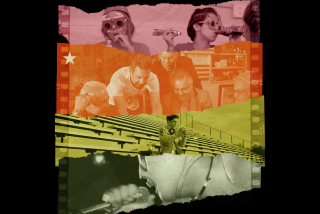‘Chicanos’ Moves in Two Directions
The conflict between what company director and choreographer Gema Sandoval’s program note called “my traditional self” and “my activist self” made her ambitious, full-evening epic “Chicanos: The Spirit of Aztlan” a fascinating failure in its premiere Saturday at the Japan America Theatre.
Divided into eight sections, with half the choreography newly created and half recycled from Danza Floricanto/USA repertory, this exploration of Mexican American cultural identity showcased Sandoval’s activism in a remarkably single-minded view of the Spanish conquest. No tribute to Christianization here. Instead, we saw people terrorized and subjugated in front of a church window, with the cross less the key symbol than a conquistador with a whip.
Such images led to an attempt to summarize cultural colonialism through three duets showing the interaction of Spanish men and native women, perhaps the most artful of Sandoval’s new choreography.
But as soon as she reached 1848, when, in the words of her program note and narration, “Los Californios from the north became part of the United States,” Sandoval’s “traditional self” took over, and the performance became one long party. Energetic celebrations of the work ethic, authoritative tributes to Chicano roots in different regions of mother Mexico and uneven versions of the pop dances that Latinos found once they got to U.S. cities dominated much of Act 2.
A few glints of activism remained, but they seemed surprisingly sugarcoated. “In 1848, the first wetbacks were born,” Sandoval informed us, but her depiction of their journey to California became a kind of game: border agents dancing traditional percussive steps in place while spirited, colorfully costumed dancers deftly eluded them. Breaking a pinata couldn’t have been more playful.
In her somber “Las Tres Fridas” section, Sandoval depicted the responsibility of the artist to learn from the past, and you could argue that she evaded that responsibility by not taking more seriously the dangers of coming to this country as a mojado and working as a bracero. A celebration of survival such as Alvin Ailey’s solo “Cry” reminds you how hard-won that survival can be, but the entertainer in Sandoval made it look far too easy.
What seemed difficult--indeed, something of a struggle--was the dancing. Performances of folklore from Nayarit, Huasteca, Veracruz and Jalisco found the spirited Danza Floricanto soloists and ensemble on familiar turf, but they often looked stiff and tentative in such unfamiliar show-dance challenges as the strut and slink in the “Low Rider” and “Pachuco” sections.
Gema M. Sandoval (the choreographer’s daughter) always delivered the purest statement of a scene’s style and mood, while Sergio Mora, masked as the god Quetzalcoatl, managed to execute one-legged spins and complex footwork in perfect unison with the women’s ensemble.
Although lighting designer Monique L’Heureux enforced considerable variety, “Chicanos” needed a supportive production design--extensive documentary projections, perhaps, that would have made the dancers seem embedded in Mexican and Mexican American history rather than appear as a small, isolated symbol of something much greater than they could possibly represent unaided.
More to Read
The biggest entertainment stories
Get our big stories about Hollywood, film, television, music, arts, culture and more right in your inbox as soon as they publish.
You may occasionally receive promotional content from the Los Angeles Times.










